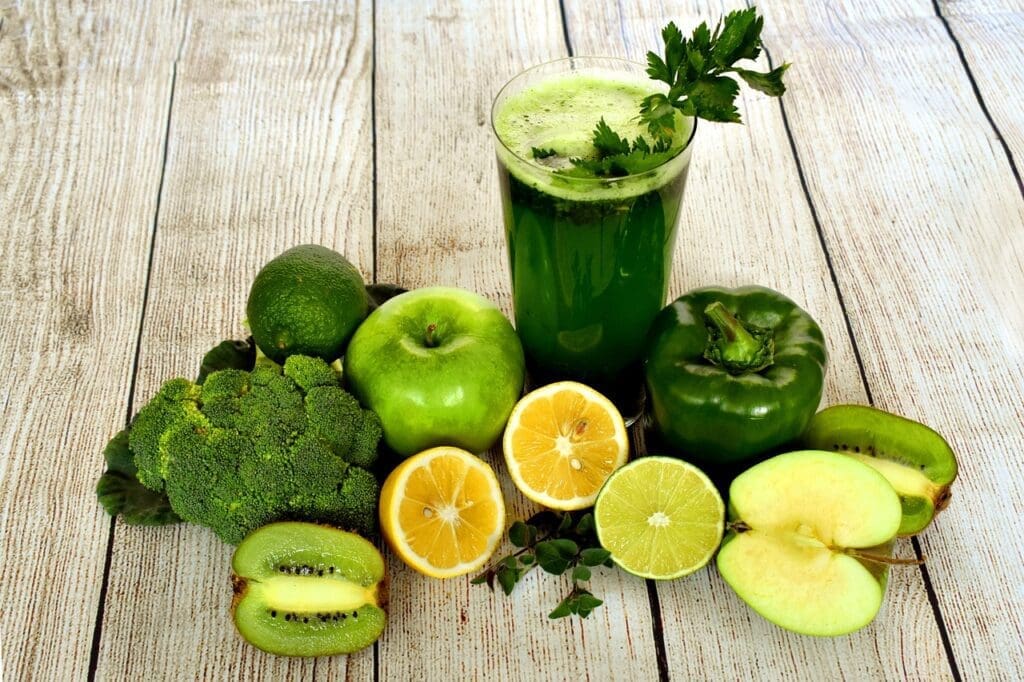A juicing diet, also known as a juice cleanse or Juice fast, is a diet where a person consumes only fruit and vegetable juices for a certain period. The goal of a juicing diet to lose weight is to detoxify the body, promote weight loss, and improve overall health.
During a juice cleanse, solid foods are eliminated from the diet, and the body is nourished with fresh juices that are rich in vitamins, minerals, and antioxidants.
One of the main ways that a juicing diet aids in weight loss is by reducing calorie intake. Since fruits and vegetables are low in calories but high in nutrients, consuming them in juice form significantly reduces calorie consumption while still providing the body with essential vitamins and minerals. Additionally, the high water content in juices helps to keep you hydrated and can help curb hunger cravings.

Benefits of a Juicing Diet To Lose Weight
- Increased nutrient intake: Juices are packed with essential vitamins, minerals, and antioxidants that are easily absorbed by the body. By consuming a variety of fruits and vegetables in juice form, you can ensure that your body is getting all the nutrients it needs to function properly.
- Reduced calorie intake: Juices are naturally low in calories but high in nutrients. By replacing solid foods with juices during a cleanse, you can significantly reduce your calorie intake while still providing your body with essential nutrients.
- Improved digestion: Juices are easier for the body to digest compared to solid foods. This allows your digestive system to take a break and can help improve digestion overall. Improved digestion can lead to better nutrient absorption and can also help reduce bloating and discomfort.
- Boosted metabolism: Some fruits and vegetables, such as grapefruit and celery, have been shown to boost metabolism. Including these ingredients in your juices can help increase your body’s calorie-burning potential and aid in weight loss.
- Reduced inflammation: Many fruits and vegetables have anti-inflammatory properties. By consuming them in juice form, you can help reduce inflammation in the body, which is often associated with weight gain and other health issues.
Getting Started: Preparing for a Juice Cleanse
Before starting a juice cleanse, it is important to consult with a healthcare professional, especially if you have any underlying health conditions or are taking medication. They can guide and ensure a juice cleanse is safe for you.
Choosing the right juicer is also important. Different types of juicers are available, such as centrifugal juicers and masticating juicers. Centrifugal juicers are more affordable and work quickly, but they may not extract as much juice from fruits and vegetables. Masticating juicers are slower but tend to extract more juice and retain more nutrients.
When selecting fruits and vegetables for your juices, it is important to choose organic produce whenever possible to avoid consuming pesticides and other harmful chemicals. It is also important to choose a variety of fruits and vegetables to ensure that you are getting a wide range of nutrients.
Preparing your body for a juice cleanse is also important. It is recommended to gradually reduce your intake of caffeine, processed foods, and animal products in the days leading up to your cleanse. This can help minimize withdrawal symptoms and make the transition to a juice cleanse easier.
Juice Diet 5 Days: A Comprehensive Plan for Quick Weight Loss
A 5-day Juicing Diet To Lose Weight can effectively jumpstart weight loss and detoxify the body. Here is a sample plan for a 5-day juice cleanse:
- Day 1:
- Morning: Green juice (kale, spinach, cucumber, apple)
- Mid-morning: Carrot-orange juice
- Lunch: Beetroot juice
- Afternoon snack: Watermelon juice
- Dinner: Tomato-celery juice
- Evening snack: Pineapple-mint juice
- Day 2:
- Morning: Green juice (kale, spinach, cucumber, apple)
- Mid-morning: Carrot-orange juice
- Lunch: Cucumber-mint juice
- Afternoon snack: Watermelon juice
- Dinner: Tomato-celery juice
- Evening snack: Pineapple-mint juice
- Day 3:
- Morning: Green juice (kale, spinach, cucumber, apple)
- Mid-morning: Carrot-orange juice
- Lunch: Beetroot juice
- Afternoon snack: Watermelon juice
- Dinner: Tomato-celery juice
- Evening snack: Pineapple-mint juice
- Day 4:
- Morning: Green juice (kale, spinach, cucumber, apple)
- Mid-morning: Carrot-orange juice
- Lunch: Cucumber-mint juice
- Afternoon snack: Watermelon juice
- Dinner: Tomato-celery juice
- Evening snack: Pineapple-mint juice
- Day 5:
- Morning: Green juice (kale, spinach, cucumber, apple)
- Mid-morning: Carrot-orange juice
- Lunch: Beetroot juice
- Afternoon snack: Watermelon juice
- Dinner: Tomato-celery juice
- Evening snack: Pineapple-mint juice
During a 5-day Juicing Diet To Lose Weight, it is important to stay hydrated by drinking plenty of water in addition to the juices. It is also important to listen to your body and adjust the cleanse as needed. If you feel weak or lightheaded, adding a small meal or snack to your cleanse may be necessary.
Potential side effects of a 5-day juice cleanse can include headaches, fatigue, and irritability. These symptoms are often temporary and can be managed by staying hydrated, getting plenty of rest, and practicing self-care.
Juice Diet Chart: A Guide to Planning Your Daily Juices
Creating a Juicing Diet To Lose Weight chart can help you stay organized and ensure that you get various nutrients during your cleanse. Here is a sample juice diet chart:
- Day 1:
- Morning: Green juice (kale, spinach, cucumber, apple)
- Mid-morning: Carrot-orange juice
- Lunch: Beetroot juice
- Afternoon snack: Watermelon juice
- Dinner: Tomato-celery juice
- Evening snack: Pineapple-mint juice
- Day 2:
- Morning: Green juice (kale, spinach, cucumber, apple)
- Mid-morning: Carrot-orange juice
- Lunch: Cucumber-mint juice
- Afternoon snack: Watermelon juice
- Dinner: Tomato-celery juice
- Evening snack: Pineapple-mint juice
- Day 3:
- Morning: Green juice (kale, spinach, cucumber, apple)
- Mid-morning: Carrot-orange juice
- Lunch: Beetroot juice
- Afternoon snack: Watermelon juice
- Dinner: Tomato-celery juice
- Evening snack: Pineapple-mint juice
- Day 4:
- Morning: Green juice (kale, spinach, cucumber, apple)
- Mid-morning: Carrot-orange juice
- Lunch: Cucumber-mint juice
- Afternoon snack: Watermelon juice
- Dinner: Tomato-celery juice
- Evening snack: Pineapple-mint juice
- Day 5:
- Morning: Green juice (kale, spinach, cucumber, apple)
- Mid-morning: Carrot-orange juice
- Lunch: Beetroot juice
- Afternoon snack: Watermelon juice
- Dinner: Tomato-celery juice
- Evening snack: Pineapple-mint juice
It is important to note that this is just a sample Juicing Diet To Lose Weight chart and can be customized to fit your taste preferences and nutritional needs. It is also important to listen to your body and adjust the cleanse as needed.
Juice Diet 30 Days: A Long-Term Plan for Sustainable Weight Loss

A 30-day Juicing Diet To Lose Weight is a cleanse that can be a more challenging but rewarding way to achieve sustainable weight loss. Here is a sample plan for a 30-day juice cleanse:
- Week 1:
- Morning: Green juice (kale, spinach, cucumber, apple)
- Mid-morning: Carrot-orange juice
- Lunch: Beetroot juice
- Afternoon snack: Watermelon juice
- Dinner: Tomato-celery juice
- Evening snack: Pineapple-mint juice
- Week 2:
- Morning: Green juice (kale, spinach, cucumber, apple)
- Mid-morning: Carrot-orange juice
- Lunch: Cucumber-mint juice
- Afternoon snack: Watermelon juice
- Dinner: Tomato-celery juice
- Evening snack: Pineapple-mint juice
- Week 3:
- Morning: Green juice (kale, spinach, cucumber, apple)
- Mid-morning: Carrot-orange juice
- Lunch: Beetroot juice
- Afternoon snack: Watermelon juice
- Dinner: Tomato-celery juice
- Evening snack: Pineapple-mint juice
- Week 4:
- Morning: Green juice (kale, spinach, cucumber, apple)
- Mid-morning: Carrot-orange juice
- Lunch: Cucumber-mint juice
- Afternoon snack: Watermelon juice
- Dinner: Tomato-celery juice
- Evening snack: Pineapple-mint juice
During a 30-day juice cleanse, it is important to stay hydrated by drinking plenty of water in addition to the juices. It is also important to listen to your body and adjust the cleanse as needed. If you feel weak or lightheaded, adding a small meal or snack to your cleanse may be necessary.
Staying motivated during a longer cleanse can be challenging. Setting small goals and rewarding yourself for reaching them can be helpful. Finding support from friends, family, or online communities can also provide encouragement and accountability.
Juice Diet Detox: Cleansing Your Body and Mind
A juice detox is a more intense form of a juice cleanse that focuses on cleansing the body and mind. During a juice detox, the goal is to eliminate toxins from the body and promote overall wellness. Here are some tips for a successful juice detox:
- Start with a shorter detox: If you are new to juice detoxes, it is recommended to start with a shorter duration, such as 3-5 days, and gradually increase the length as you become more comfortable.
- Stay hydrated: Drinking plenty of water is essential during a juice detox to help flush out toxins and keep your body hydrated.
- Practice self-care: During a juice detox, it is important to take care of yourself physically and mentally. This can include activities such as yoga, meditation, or relaxing baths.
- Listen to your body: Pay attention to how you feel during the detox and adjust as needed. If you feel weak or lightheaded, you may need to add a small meal or snack to your cleanse.
- Be mindful of detox symptoms: During a Juicing Diet To Lose Weight detox, it is common to experience symptoms such as headaches, fatigue, or irritability. These symptoms are often temporary and can be managed by staying hydrated, getting plenty of rest, and practicing self-care.
Juice Diet Ideas: Delicious and Nutritious Recipes for Every Taste
One of the great things about juicing is that there are endless possibilities when it comes to creating delicious and nutritious juice recipes. Here are some ideas for fruit-based and vegetable-based juice recipes:
Fruit-based juice recipes:
- Tropical Paradise: Pineapple, mango, and orange
- Berry Blast: Strawberries, blueberries, and raspberries
- Citrus Sunrise: Grapefruit, orange, and lemon
- Watermelon Cooler: Watermelon, cucumber, and mint
Vegetable-based juice recipes:
- Green Goddess: Kale, spinach, cucumber, celery, and apple
- Beetroot Boost: Beetroot, carrot, ginger, and lemon
- Cucumber Refresher: Cucumber, mint, lime, and ginger
- Tomato Zinger: Tomato, celery, carrot, and jalapeno
Feel free to experiment with different combinations of fruits and vegetables to create your own unique Juicing Diet To Lose Weight recipes. You can also add herbs and spices such as ginger or turmeric for added flavor and health benefits.
Tips for Success: Staying Motivated and Overcoming Challenges
Staying motivated during a juice cleanse or detox can be challenging at times. Here are some tips to help you stay on track and overcome challenges:
- Set realistic goals: It is important to set realistic goals for your juice cleanse or detox. This can help you stay motivated and prevent feelings of disappointment or failure.
- Find support: Having a support system can make a big difference in staying motivated during a juice cleanse or detox. This can be friends, family members, or online communities who are also going through a similar experience.
- Manage cravings: It is normal to experience cravings during a juice cleanse or detox. To manage cravings, try distracting yourself with activities such as going for a walk or practicing a hobby. You can also try drinking herbal tea or chewing on a piece of sugar-free gum.
- Stay active: During a Juicing Diet To Lose Weight, cleanse, or detox, staying active can help boost your mood and energy levels. Engage in light exercise such as walking, yoga, or stretching to keep your body moving.
Achieving Your Weight Loss Goals with a Juicing Diet To Lose Weight
In conclusion, a juicing diet can be an effective way to achieve weight loss and improve overall health. By consuming fresh juices that are packed with essential nutrients, you can nourish your body while reducing calorie intake.
Whether you choose to do a short-term juice cleanse or a longer-term juice detox, it is important to consult with a healthcare professional and listen to your body throughout the process. With proper planning and preparation, a juicing diet can help you achieve your weight loss goals and improve your overall well-being.
FAQs
What is a juicing diet?
A juicing diet involves consuming only fresh fruit and vegetable juices for a certain period of time, usually a few days to a few weeks.
How does a juicing diet help with weight loss?
A juicing diet can help with weight loss by reducing calorie intake and increasing nutrient intake. Juices are low in calories but high in nutrients, which can help to reduce cravings and promote feelings of fullness.
What are the benefits of a juicing diet?
The benefits of a juicing diet include weight loss, improved digestion, increased energy, clearer skin, and improved overall health.
What are the potential risks of a juicing diet?
The potential risks of a juicing diet include nutrient deficiencies, low blood sugar, and gastrointestinal issues such as bloating and diarrhea. It is important to consult with a healthcare professional before starting a juicing diet.
What fruits and vegetables are best for juicing?
Fruits and vegetables that are high in water content and nutrients are best for juicing. Some examples include kale, spinach, cucumber, celery, apples, and carrots.
How often should I juice?
The frequency of juicing depends on individual goals and preferences. Some people juice daily as part of their regular diet, while others may do a juicing cleanse for a few days or weeks at a time.
Can I eat solid food while on a juicing diet?
Some Juicing Diet To Lose Weight allow for small amounts of solid food, while others require only juice consumption. It is important to follow the guidelines of the specific juicing diet being followed.








Be First to Comment